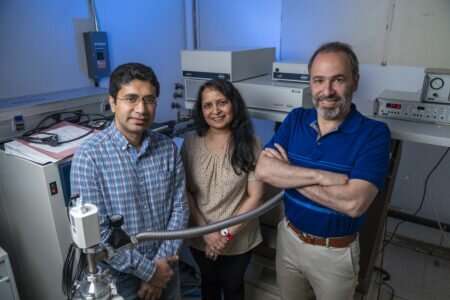Study details regulation of a multi-drug transporter

Vanderbilt University researchers have discovered how a protein pump distinguishes between chemicals that it will expel from a cell and inhibitors that block its action.
The pump, called P-glycoprotein, protects cells by removing potentially harmful chemicals, but it contributes to drug resistance when those chemicals are therapeutic drugs—which poses a particular problem for cancer treatment. The new findings, reported in the journal Science, could guide the development of more efficient inhibitors to prevent cancer cell resistance to chemotherapy.
The studies answered a long-standing question about P-glycoprotein, said Hassane Mchaourab, Ph.D., Louise B. McGavock Professor of Molecular Physiology and Biophysics.
Mchaourab describes P-glycoprotein as a two-part molecular machine: an engine that burns ATP and a transmembrane domain that provides a passageway for the substrate (a molecule moved by the transporter). ATP energy harnessed by the engine powers the conformational changes that move chemicals out of cells.
What wasn't clear is "how the ATP engine knows that a chemical is bound in the transmembrane domain that is a molecular 'mile' away," Mchaourab said.
"In humans, this transporter spits out chemicals that include antibiotics, anti-cancer chemotherapy drugs, antidepressants, opioids … what makes a molecule a substrate for this remarkably diverse pump, and what makes a molecule an inhibitor?"
The current studies follow findings that Mchaourab and his colleagues reported in the journal Nature two years ago. P-glycoprotein has two ATP-burning sites, and the researchers discovered using a spectroscopy method (double electron-electron resonance, DEER) that the two sites are structurally asymmetric—first one site and then the second site burns ATP. They also found that the two sequential steps are related to substrate recognition.
Mchaourab remembers Vanderbilt University Medical Center science writer Bill Snyder asking a question that gave him pause—why would nature design an asymmetric engine?
"I answered that maybe this is the way the transporter knows if it's loaded with substrate or not," Mchaourab said. "But we had done all of our experiments with substrate present—because that's how the transporter works." The researchers hadn't investigated the structure of the ATP-burning sites in the absence of substrate.
"It was a Friday, and I woke that night thinking of Bill's question," Mchaourab recalled. "On Monday, I asked Reza (a postdoctoral fellow) to repeat the experiments and remove the substrate. And voila, the engine became symmetric—it didn't matter which side burned ATP first."
In additional studies with P-glycoprotein third-generation inhibitors, the researchers found that these inhibitors also stabilize a symmetric state, but one that is different from the empty state.
"An inhibitor ties up the transporter so that it can't go to the asymmetric state and can't carry out the power stroke—the step at which the transporter moves from what we call inward-facing to outward-facing and spits out the substrate," Mchaourab said.
Knowing the different conformations of P-glycoprotein that are stabilized by substrates versus inhibitors will make it possible to screen for more effective inhibitor molecules. It might also help researchers understand why existing inhibitors performed poorly in clinical trials.
"P-glycoprotein is such an important clinical target," Mchaourab said. "Now we realize that inhibitors also work on the asymmetry of the engine. P-glycoprotein knows if it's empty, or if it's bound to a substrate or inhibitor by modulating the level of asymmetry."
More information: Reza Dastvan et al. Mechanism of allosteric modulation of P-glycoprotein by transport substrates and inhibitors, Science (2019). DOI: 10.1126/science.aav9406
Provided by Vanderbilt University

















